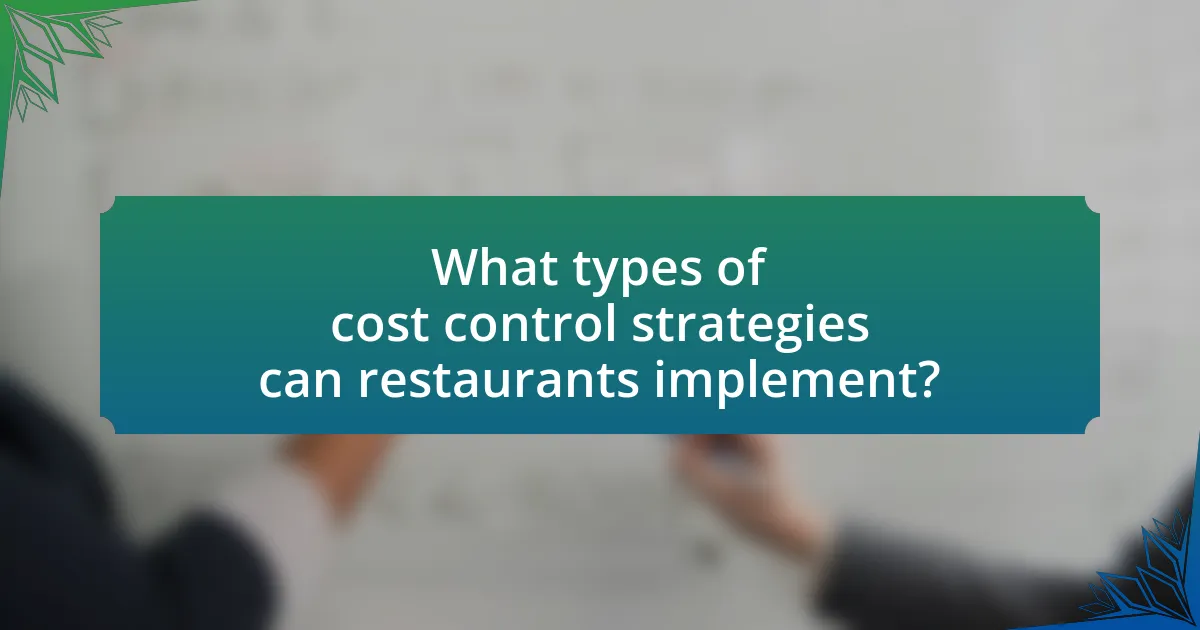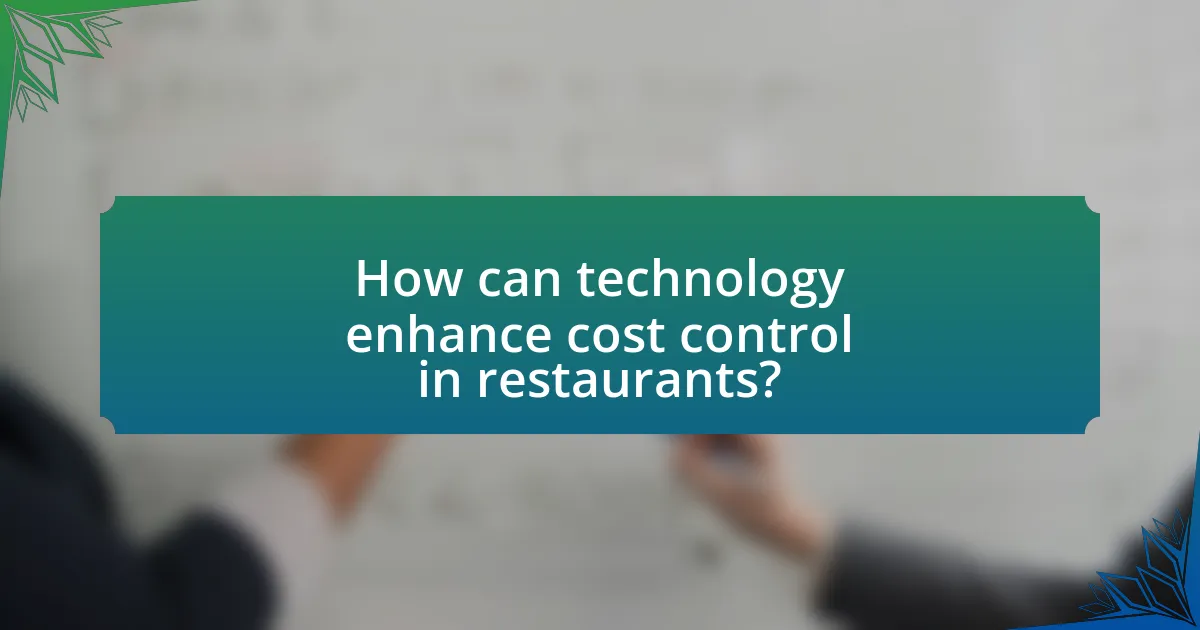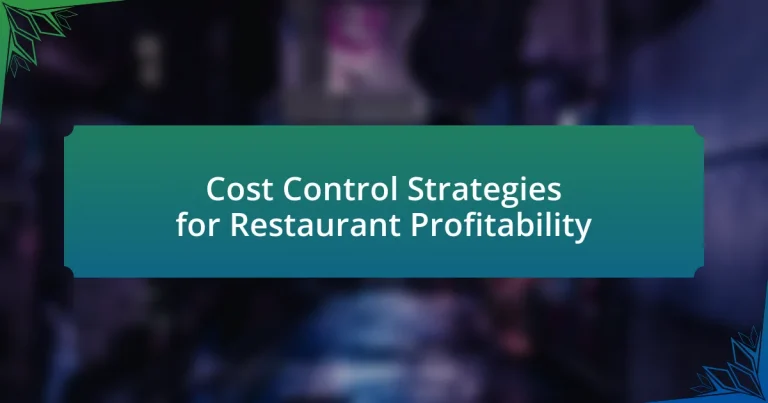Cost control strategies are essential for enhancing restaurant profitability, focusing on effective inventory management, labor cost optimization, menu engineering, and waste reduction. Key components include budgeting, monitoring expenses, and implementing standard operating procedures, which collectively improve financial health and operational efficiency. The article outlines how these strategies impact profit margins, the importance of measuring their effectiveness through key performance indicators, and the financial challenges faced without proper cost control. Additionally, it discusses the role of technology and staff training in optimizing cost management, as well as best practices for fostering a culture of cost awareness among employees.

What are Cost Control Strategies for Restaurant Profitability?
Cost control strategies for restaurant profitability include effective inventory management, labor cost optimization, menu engineering, and waste reduction. Effective inventory management involves tracking stock levels and using just-in-time ordering to minimize excess. Labor cost optimization focuses on scheduling staff according to peak hours and cross-training employees to enhance flexibility. Menu engineering entails analyzing the profitability of menu items and adjusting offerings based on food cost and customer preferences. Waste reduction strategies, such as portion control and recycling, help minimize food waste and associated costs. Implementing these strategies can lead to improved profit margins and overall financial health for restaurants.
How do cost control strategies impact restaurant profitability?
Cost control strategies significantly enhance restaurant profitability by reducing unnecessary expenses and optimizing resource allocation. Effective management of food costs, labor expenses, and overhead can lead to improved profit margins. For instance, implementing inventory management systems can minimize food waste, which, according to the Food Waste Reduction Toolkit by the USDA, can save restaurants up to 10% of their food costs. Additionally, labor scheduling software can ensure that staffing levels align with customer demand, potentially reducing labor costs by 5-15%. These strategies collectively contribute to a more efficient operation, ultimately increasing the bottom line.
What are the key components of effective cost control strategies?
Effective cost control strategies include budgeting, monitoring expenses, and implementing standard operating procedures. Budgeting establishes financial limits and expectations, allowing restaurants to allocate resources efficiently. Monitoring expenses involves regularly reviewing financial reports to identify variances and areas for improvement, which can lead to timely adjustments. Implementing standard operating procedures ensures consistency in operations, reducing waste and inefficiencies. According to a study by the National Restaurant Association, effective cost control can improve profitability by up to 15%, highlighting the importance of these components in achieving financial success in the restaurant industry.
How can restaurants measure the effectiveness of these strategies?
Restaurants can measure the effectiveness of cost control strategies by analyzing key performance indicators (KPIs) such as food cost percentage, labor cost percentage, and overall profit margins. By tracking these metrics over time, restaurants can determine if their strategies are leading to reduced costs and increased profitability. For instance, a study by the National Restaurant Association indicates that a 1% reduction in food costs can significantly enhance profit margins, demonstrating the direct impact of effective cost control measures. Additionally, conducting regular inventory audits and comparing actual costs against budgeted figures provides concrete data to assess the success of implemented strategies.
Why is cost control essential for restaurant success?
Cost control is essential for restaurant success because it directly impacts profitability and operational efficiency. Effective cost control allows restaurants to manage expenses related to food, labor, and overhead, ensuring that profit margins remain healthy. According to the National Restaurant Association, food costs typically account for 28-35% of a restaurant’s total sales, making it crucial to monitor and optimize these expenses. Additionally, controlling labor costs, which can represent up to 30% of total expenses, helps maintain a balanced budget and prevents financial strain. By implementing cost control strategies, restaurants can enhance their financial stability, adapt to market fluctuations, and ultimately achieve long-term success.
What financial challenges do restaurants face without cost control?
Restaurants face significant financial challenges without cost control, including increased food and labor costs, reduced profit margins, and cash flow issues. Without effective cost management, food waste can escalate, leading to higher expenses; for instance, the National Restaurant Association reports that food waste can account for up to 10% of a restaurant’s total costs. Additionally, labor costs can spiral out of control if staffing levels are not monitored, resulting in overstaffing during slow periods. This mismanagement can lead to profit margins shrinking, as the average restaurant operates on a profit margin of only 3-5%. Furthermore, without cost control, restaurants may struggle with cash flow, making it difficult to cover operational expenses and invest in growth opportunities.
How does cost control influence customer satisfaction and retention?
Cost control significantly influences customer satisfaction and retention by ensuring that restaurants can maintain quality while managing expenses. When a restaurant effectively controls costs, it can allocate resources to enhance the dining experience, such as improving food quality, service, and ambiance. For instance, a study by the National Restaurant Association found that 70% of customers are more likely to return to a restaurant that consistently delivers high-quality food and service, which is often made possible through efficient cost management. Additionally, effective cost control can lead to competitive pricing, making it more attractive for customers to choose a restaurant over others, thereby increasing retention rates.

What types of cost control strategies can restaurants implement?
Restaurants can implement several cost control strategies, including inventory management, portion control, labor management, and menu engineering. Effective inventory management involves tracking stock levels and minimizing waste, which can reduce food costs by up to 10% according to industry studies. Portion control ensures that servings are consistent, preventing over-serving and waste, which can save approximately 5-10% on food costs. Labor management focuses on optimizing staff schedules and productivity, potentially lowering labor costs by 3-5%. Menu engineering involves analyzing the profitability of menu items and adjusting pricing or offerings to enhance margins, which can increase overall profitability by 10-15%. These strategies collectively contribute to improved financial performance in the restaurant industry.
How can menu engineering contribute to cost control?
Menu engineering contributes to cost control by optimizing menu design to enhance profitability and reduce waste. By analyzing the popularity and profitability of menu items, restaurants can identify high-margin dishes and promote them, while minimizing or removing low-performing items that do not contribute to overall revenue. Research indicates that effective menu engineering can increase food cost efficiency by up to 15%, as it encourages strategic pricing and portion control, ultimately leading to better inventory management and reduced food waste.
What factors should be considered in menu pricing?
Menu pricing should consider food costs, labor costs, market demand, competition, and perceived value. Food costs represent the direct expenses associated with ingredients, which typically account for 25-35% of menu prices to maintain profitability. Labor costs include wages and benefits for staff, influencing overall pricing strategies. Market demand affects how much customers are willing to pay, often requiring adjustments based on trends and customer preferences. Competition analysis helps determine pricing relative to similar establishments, ensuring competitiveness without sacrificing margins. Lastly, perceived value relates to how customers view the quality and experience offered, which can justify higher prices if aligned with expectations.
How can portion control reduce food costs?
Portion control can reduce food costs by minimizing waste and ensuring consistent serving sizes. When restaurants implement portion control, they can accurately predict ingredient usage, leading to better inventory management and reduced over-purchasing. According to a study by the National Restaurant Association, effective portion control can lead to a reduction in food waste by up to 20%, directly impacting overall food costs. By serving standardized portions, restaurants also enhance customer satisfaction, as guests receive consistent meals, which can lead to repeat business and increased profitability.
What role does inventory management play in cost control?
Inventory management plays a crucial role in cost control by optimizing stock levels and reducing waste. Effective inventory management ensures that restaurants maintain the right amount of ingredients, minimizing excess that can lead to spoilage and financial loss. According to a study by the National Restaurant Association, proper inventory control can reduce food costs by up to 10%, significantly impacting overall profitability. By tracking inventory accurately, restaurants can make informed purchasing decisions, streamline operations, and ultimately enhance their financial performance.
How can restaurants optimize their inventory turnover?
Restaurants can optimize their inventory turnover by implementing just-in-time inventory management, which reduces excess stock and minimizes waste. This approach allows restaurants to order ingredients based on actual demand rather than estimates, ensuring fresher products and lower holding costs. For instance, a study by the National Restaurant Association found that restaurants using just-in-time practices can reduce food waste by up to 30%, directly impacting profitability. Additionally, utilizing inventory management software can provide real-time data on stock levels and sales trends, enabling more accurate forecasting and timely reordering. This data-driven approach further enhances inventory turnover by aligning supply with customer demand.
What tools are available for effective inventory tracking?
Effective inventory tracking tools include inventory management software, barcode scanning systems, and RFID technology. Inventory management software, such as Square for Restaurants and MarketMan, allows restaurants to monitor stock levels, track orders, and generate reports, enhancing accuracy and efficiency. Barcode scanning systems streamline the process by enabling quick data entry and reducing human error, while RFID technology provides real-time tracking of inventory items, improving visibility and control. These tools collectively support cost control strategies by minimizing waste and optimizing stock levels, which are crucial for maintaining profitability in the restaurant industry.

How can technology enhance cost control in restaurants?
Technology enhances cost control in restaurants by streamlining operations, improving inventory management, and optimizing labor costs. For instance, point-of-sale (POS) systems provide real-time sales data, allowing restaurant managers to track which menu items are most profitable and adjust inventory accordingly. Additionally, inventory management software can automate stock tracking, reducing waste and ensuring that ingredients are ordered only when necessary, which can lead to a reduction in food costs by up to 10-15%. Labor management tools help in scheduling staff efficiently based on peak hours, which can decrease labor costs by 5-10%. These technological solutions not only improve operational efficiency but also contribute to overall profitability by minimizing unnecessary expenses.
What software solutions are available for cost management?
Software solutions available for cost management include tools like QuickBooks, FreshBooks, and Xero, which facilitate budgeting, expense tracking, and financial reporting. These platforms enable businesses to monitor their financial health in real-time, allowing for informed decision-making. For instance, QuickBooks offers features such as invoicing and payroll management, which are essential for maintaining accurate financial records. Additionally, FreshBooks provides time tracking and project management capabilities, enhancing overall cost efficiency. Xero integrates with various applications, streamlining financial processes and improving visibility into cash flow. These solutions are widely adopted in the restaurant industry to enhance profitability through effective cost control strategies.
How can point-of-sale systems aid in tracking costs?
Point-of-sale systems aid in tracking costs by providing real-time data on sales, inventory, and labor expenses. These systems automatically record each transaction, allowing restaurant managers to analyze cost trends and identify areas for improvement. For instance, by integrating inventory management with sales data, a point-of-sale system can highlight discrepancies between expected and actual food costs, enabling more accurate forecasting and waste reduction. Additionally, detailed reporting features allow for the monitoring of labor costs against sales performance, ensuring optimal staffing levels and minimizing overages. This data-driven approach supports informed decision-making, ultimately enhancing profitability.
What are the benefits of using analytics for cost control?
Using analytics for cost control significantly enhances decision-making and operational efficiency in restaurants. Analytics provides insights into spending patterns, allowing restaurant managers to identify areas of overspending and optimize resource allocation. For instance, a study by Deloitte found that organizations leveraging data analytics can reduce costs by up to 20% through improved inventory management and waste reduction. Additionally, analytics enables real-time monitoring of financial metrics, facilitating timely adjustments to pricing strategies and menu offerings, which can lead to increased profitability.
How can staff training improve cost control measures?
Staff training can significantly improve cost control measures by enhancing employee efficiency and reducing waste. When staff members are well-trained, they understand operational procedures, which leads to better resource management and minimizes errors that can result in financial losses. For instance, a study by the National Restaurant Association found that effective training programs can reduce food waste by up to 20%, directly impacting overall costs. Additionally, trained employees are more adept at using equipment properly, which decreases maintenance costs and extends the lifespan of assets. This combination of improved efficiency and reduced waste ultimately contributes to better cost control in restaurant operations.
What key areas should staff be trained in for effective cost management?
Staff should be trained in budgeting, inventory management, and waste reduction for effective cost management. Budgeting skills enable staff to understand financial constraints and allocate resources efficiently. Inventory management training helps staff track stock levels, minimize over-ordering, and reduce spoilage, which is crucial in the restaurant industry where food costs can significantly impact profitability. Waste reduction techniques, such as portion control and proper food storage, further enhance cost management by decreasing unnecessary expenses. These areas are essential as they directly influence a restaurant’s bottom line and overall financial health.
How can employee engagement impact cost control success?
Employee engagement significantly enhances cost control success by fostering a motivated workforce that is more productive and efficient. Engaged employees are likely to take ownership of their roles, leading to reduced waste and improved operational efficiency. For instance, a Gallup study found that organizations with high employee engagement levels experience 21% greater profitability, which directly correlates with effective cost management. Additionally, engaged employees are more inclined to identify cost-saving opportunities and implement best practices, further contributing to overall financial performance.
What are some best practices for implementing cost control strategies?
Best practices for implementing cost control strategies include establishing a detailed budget, regularly monitoring expenses, and utilizing technology for tracking costs. A detailed budget provides a clear financial framework, allowing restaurants to allocate resources effectively and identify areas for potential savings. Regular monitoring of expenses helps in identifying variances from the budget, enabling timely adjustments. Utilizing technology, such as inventory management systems, can streamline operations and reduce waste, which is crucial in the restaurant industry where food costs can significantly impact profitability. According to a study by the National Restaurant Association, effective cost control can improve a restaurant’s profit margins by up to 10%.
How can restaurants create a culture of cost awareness among staff?
Restaurants can create a culture of cost awareness among staff by implementing regular training sessions focused on cost management and operational efficiency. These training sessions should include practical examples of how food waste impacts profitability, as studies show that reducing food waste can save restaurants up to 10% of their food costs. Additionally, establishing clear communication channels for sharing cost-related metrics, such as food cost percentages and labor costs, empowers staff to understand their role in financial performance. Incentivizing staff through performance-based rewards linked to cost-saving initiatives further reinforces this culture, as research indicates that employee engagement in cost control can lead to a 15% increase in overall profitability.
What common pitfalls should restaurants avoid in cost control efforts?
Restaurants should avoid common pitfalls such as neglecting inventory management, failing to analyze food costs, and overlooking labor expenses in their cost control efforts. Neglecting inventory management can lead to overstocking or spoilage, which directly impacts profitability. Failing to analyze food costs prevents restaurants from identifying overpriced ingredients or wasteful practices, resulting in inflated expenses. Additionally, overlooking labor expenses can cause significant financial strain, as labor is often one of the largest costs for restaurants. According to the National Restaurant Association, labor costs can account for 30% to 35% of total sales, making it crucial for restaurants to monitor and manage these expenses effectively.




